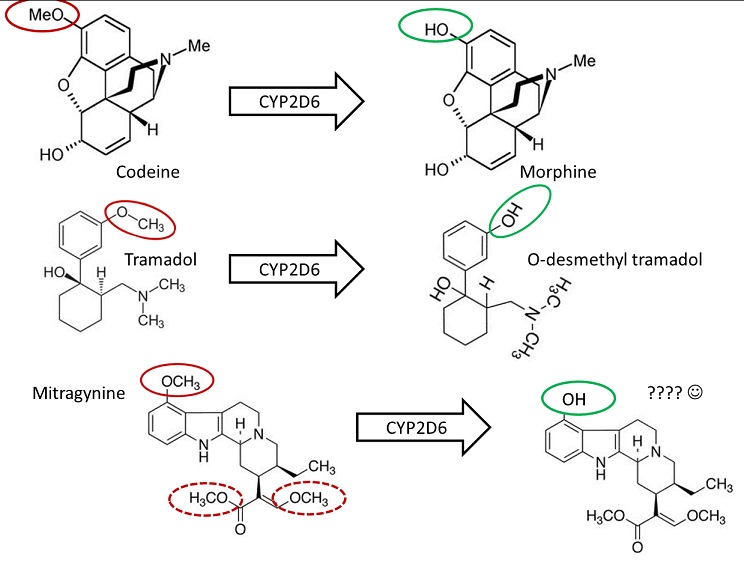In this topic I want to shed some light on the functions and implications of the CYP2D6 liver enzyme. Basically this enzyme metabolizes alkaloids. It either actives or deactivates compounds, depending on the substance used.
wiki wrote:Cytochrome P450 2D6 (CYP2D6), a member of the cytochrome P450 mixed-function oxidase system, is one of the most important enzymes involved in the metabolism of xenobiotics in the body. Also, many substances are bioactivated by CYP2D6 to form their active compounds. While CYP2D6 is involved in the oxidation of a wide range of substrates of all the CYPs, there is considerable variability in its expression in the liver. The gene is located near two cytochrome P450 pseudogenes on chromosome 22q13.1. Alternatively spliced transcript variants encoding different isoforms have been found for this gene.[1]
wikiTake a look at this diagram on opiates:

As you can the activity of Mitragynine (MG) depends on the CYP2D6 enzyme. As it turns out, some portion our species has less or none of this enzyme and thus they cannot metabolize. If you tried Kratom and had no effect, this is probably the case.
wiki wrote:CYP2D6 shows the largest phenotypical variability among the CYPs, largely due to genetic polymorphism. The genotype accounts for normal, reduced, and non-existent CYP2D6 function in subjects.
The CYP2D6 function in any particular subject may be described as one of the following:
poor metaboliser–these subjects have little or no CYP2D6 function
intermediate metabolizers–these subjects metabolize drugs at a rate somewhere between the poor and extensive metabolizers
extensive metaboliser–these subjects have normal CYP2D6 function
ultrarapid metaboliser–these subjects have multiple copies of the CYP2D6 gene expressed, and therefore greater-than-normal CYP2D6 function
Opiates are not the only compound metabolized by this. Ibogain as well depends on this enzyme:
Quote:Ibogaine is a psychoactive alkaloid that possesses potential as an agent to treat opiate and cocaine addiction. The primary metabolite arises via O-demethylation at the 12-position to yield 12-hydroxyibogamine. In this report, evidence is presented that theO-demethylation of ibogaine observed in human hepatic microsomes is catalyzed primarily by the polymorphically expressed cytochrome P-4502D6 (CYP2D6). An enzyme kinetic examination of ibogaineO-demethylase activity in pooled human liver microsomes suggested that two (or more) enzymes are involved in this reaction: one with a low KMapp (1.1 μM) and the other with a high KMapp (>200 μM). The lowKMapp activity comprised >95% of total intrinsic clearance. Human liver microsomes from three individual donors demonstrated similar enzyme kinetic parameters (meanKMapp = 0.55 ± 0.09 μM and 310 ± 10 μM for low and high KMactivities, respectively). However, a fourth human microsome sample that appeared to be a phenotypic CYP2D6 poor metabolizer possessed only the high KMapp activity. In hepatic microsomes from a panel of human donors, the lowKMapp ibogaine O-demethylase activity correlated with CYP2D6-catalyzed bufuralol 1′-hydroxylase activity but not with other P450 isoform-specific activities. Quinidine, a CYP2D6-specific inhibitor, inhibited ibogaineO-demethylase (IC50 = 0.2 μM), whereas other P450 isoform-specific inhibitors did not inhibit this activity. Also, of a battery of recombinant heterologously expressed human P450 isoforms, only rCYP2D6 possessed significant ibogaineO-demethylase activity. Thus, it is concluded that ibogaineO-demethylase is catalyzed by CYP2D6 and that this isoform is the predominant enzyme of ibogaine O-demethylation in humans. The potential pharmacological implications of these findings are discussed.
Quote:Approximately 5–10% of Caucasians lack a functional copy of the CYP2D6 gene and hence lack the enzyme. Such individuals are termed poor metabolizers, owing to their decreased capacity to metabolize and clear CYP2D6 substrates. Such individuals are often subject to a higher incidence of adverse drug reactions due to elevated drug concentrations. Also, for drugs that require CYP2D6-catalyzed bioactivation to a pharmacologically active metabolite (e.g. codeine → morphine), efficacy can be reduced in poor metabolizer subjects.
R. Scott Obach, John Pablo2, and Deborah C. Mash,"Cytochrome P4502D6 Catalyzes the O-Demethylation of the Psychoactive Alkaloid Ibogaine to 12-Hydroxyibogamine"I am interested to learn if there are people here who have adverse drug reactions to some compounds. For me Kratom doesn't work well. I tried it many times and couldn't understand why it didn't work. So I can be termed a 'poor metabolizer'.
And so I am curious how deep this rabbithole goes. Who has more on this?